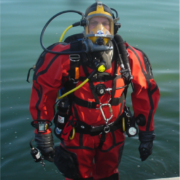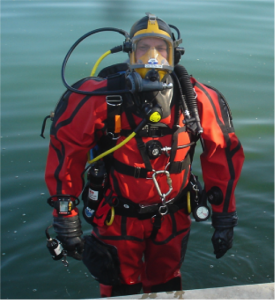Are You Prepared to go to Court?
by Thomas Powell:
In March of 2014, a simulated body recovery exercise near the east coast of North Carolina brought a concern to light for many dive teams that do not involve sworn law enforcement divers. On the day of the exercise, two senior detectives associated with a local Sheriff’s Department were working with a local search and rescue dive team for the first time. The two detectives were largely unaware of dive team operating procedures, and the dive team had not spent any considerable length of time training to adapt to the needs of Sheriff’s Department representatives. As lead crime scene investigators, the detectives, expressed worry about volunteer divers having to face an attorney in a courtroom with regard to evidence recovery and crime scene security.
Sworn law enforcement personnel are trained to deal with crime scene procedures and to follow evidence recovery protocols. Those sworn officers, deputies, or agents are then taught how to present information to a court room or court official in an honest and proper method. In a similar fashion, dive teams are taught to follow basic standards that must then be adapted to local needs and historical precedence. The problem is that many volunteer dive team members have never had to sit before a court room or defense attorney looking for problems associated with dive team actions. In most cases, volunteer divers have never even been trained on how to handle a court room scenario.
A court room can be a scary place. A defense attorney may seek to ruin a diver’s credibility, or find issues related to operational procedures. No dive team member wants to let the “bad guy” get away, or harm the credible image of his or her dive team. For this reason, a diver may crack under pressure, or become a problematic witness. Imagine you are a 19 year old volunteer who has joined a dive team in an effort to help your community and protect the people you love. You work hard, learn as much as you can, always show up, and establish true team dedication. Then one day you are the person who is tasked with recovering a child murder victim, surrounded by potential evidence, at 20 feet in zero-visibility water. You do your best and follow every standard you have learned in a methodical fashion. At the end of the day, your team and the local law enforcement representatives are proud of you and your actions.
Now fast-forward six months to a local court room where the evidence you collected helped bring a “bad guy” before the legal system. The defense attorney begins to question your methods. What did you miss because you could not see? What have you forgotten after six months of time? The attorney makes you question your skills and what you accomplished. Your concern begins to show before the jury, and you grow visibly upset because you know you did your best and now someone is questioning your abilities. This scenario could lead to the elimination of evidence and the release of a person who may have been truly guilty. This is a scenario that must be avoided if at all possible.
To compensate for a lack of basic education, the ERDI Testifying in Court program was developed to help any public safety diver be better prepared for a court room experience. This program helps a diver understand what may happen, how to dress when testifying, and even how to speak to the attorneys or a jury. A dive team must remember that this course is a fantastic preparatory tool, but then the divers must take a further step. The information learned in the Testifying in Court program must be practiced. Divers must work with leadership to cover the types of knowledge needed for a court room scenario, and then run through simulated practice scenarios to ensure diver comfort and ability when facing a real attorney.
Now go back to the court room in which you, the 19 year old volunteer was testifying. Imagine you are well-dressed and prepared with organized notes covering your actions and activities during your recovery operation. With each question, you are able to provide a confident and honest response that explains why and how you performed specific tasks. When you leave the court room that day, you know you were able to represent your team and your actions in the best manner possible. This secondary scenario is also one that would leave any diver more confident in relation to testifying during future court room scenarios.
A dive team of any sort must always be prepared to defend its actions. Data must be maintained as well as any information regarding activities, evidence collection, and scene operations. Prior to a court case, this information must be pulled and reviewed. Every step must be taken to ensure that any diver being asked to appear before court is confident, prepared, and supported in every possible fashion. To begin this process, the ERDI Testifying in Court program is an awareness-level course that can be used to better educate divers and prepare them for any court room experience that they may have never entertained before.
Thomas Powell
Instructor Trainer – Air Hogs Scuba
www.airhogsscuba.com




